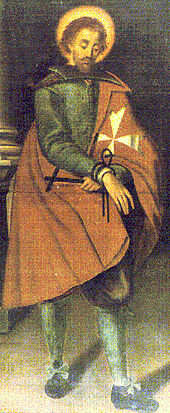Adrian Fortescue (Seliger)
Sir Adrian Fortescue (* around 1476; † July 9, 1539 in London ) was an English knight under the kings Henry VII and Henry VIII. Because of his relationship to Anne Boleyn , he was first in high regard with Henry VIII. The refusal to recognize the Supreme Act led to his overthrow and execution in the Tower of London . The Roman Catholic Church is considered a martyr and was beatified in the 19th century .
Origin and early years
Fortescue's exact year of birth is unknown. He appears for the first time in a document in 1499, at which time he was already married to his first wife, Anne Stonor. His father was Sir John Fortescue. The origin of his mother was more important for later development. She was the daughter of Sir Geoffrey Boleyn and thus great-aunt of Anne Boleyn.
On the occasion of the investiture of Prince Henry as Prince of Wales Fortescue was beaten on February 18, 1504 to the Knight Bachelor ("Sir"). Fortescue was a member of two commissions that prepared two weddings for Henry VII's children, that of Prince Arthur Tudor with Catherine of Aragón and that of Princess Margaret Tudor with King James IV of Scotland .
Campaigns and middle years
Fortescue took part, at the request of Henry VIII, for the first time in June 1513 in a campaign in France , including the battle of Guinegate . He was gentleman of the King's Privy Chamber ; the date on which this privilege was conferred is unknown. In 1517 he is mentioned in the King’s entourage at a banquet in Greenwich . His first wife Anne died on June 14, 1518, her death causing bitter inheritance disputes with her uncle Thomas Stonor and later with his son, Walter Stonor. In 1520 he followed Henry VIII to his negotiations with King Francis I of France at the Camp du Drap d'Or ; Fortescue was assigned to the Queen's entourage. He followed Henry VIII on a campaign to France again in July 1522; he served as an officer under Thomas Howard, 2nd Duke of Norfolk . In later years, for example, in 1528, he made equipment available to the king.
In 1530 he married his second wife, Anne Reade. She was then about twenty years old, and he was probably over fifty. Despite her young age, it was Anne's second marriage; she was previously married to Sir Giles Greville. The couple had five children in the following years. After Fortescue's death, she married Sir Thomas Parry . His eldest son, John Fortescue , was Chancellor of the Exchequer and Chancellor of the Duchy of Lancaster , among other offices . In this position he was followed by his half-brother Thomas Parry , the first-born son of Anne Parry from third marriage.
Confrontations with the king, overthrow and execution
Fortescue initially benefited from the overthrow of Cardinal Thomas Wolsey , as he received land from his possession. At that time he was in high esteem with Henry VIII because of his relationship to the Boleyns. In the following years there were upheavals due to Fortescues attitude in the dispute between Henry VIII and the Catholic Church. He remained Catholic and even became a Knight of the Order of Malta in 1532 , for which he most likely did not go to Malta . Only two years later the order was banned in England and property and property of the Maltese were confiscated .
That year, 1534, Fortescue stayed in London several times. He was arrested for the first time on August 29 for no apparent reason and held until November, albeit more in the form of house arrest, partly in his own home in London and elsewhere. In the spring of 1539 he was arrested again on, unspecified, accusation of high treason . A Bill of Attainder against him and others was hastily brought through Parliament by the King. The House of Commons agreed on April 28, 1539, the House of Lords on May 11, after the third reading in just two days. His relationship to Anne Boleyn no longer brought him any advantages; she had already been executed on May 19, 1536. The accused were denied any right to a defense or to be heard from witnesses. Together with Sir Thomas Dingley , Fortescue was beheaded on July 9, 1539 in the Tower of London .
Posthumously he was described as a gallant, educated man and a good officer.
beatification
The Knights of Malta preserved the memory of his person and the circumstances of his death, first in Malta itself, and later in Spain . Since the 17th century he was called the blessed, the official beatification took place under Pope Leo XIII. on May 13, 1895.
literature
- John Hungerford Pollen: Bl. Adrian Fortescue. In: Catholic Encyclopedia. , 1913, en: Wikisource .
- George Knottesford Fortescue: Fortescue, Adrian. In: Dictionary of National Biography . Volume 20, London 1889, pp. 36 f., En: Wikisource .
- Baron Thomas Fortescue Clermont: A History of the Fortescues in all its branches. Volume II, London 1869, google-books .
Notes and individual references
- ↑ see: Nine Martyrs from England and Wales
- ^ William Arthur Shaw: The Knights of England. Volume 2, Sherratt and Hughes, London 1906, p. 34.
- ^ Walter Charles Metcalfe: A Book of Knights. Mitchell and Hughes, London 1885, p. 40.
- ^ The letter of request from Henry VIII to Fortescue, dated April 1, 1528, has survived.
| personal data | |
|---|---|
| SURNAME | Fortescue, Adrian |
| BRIEF DESCRIPTION | English knight under the kings Henry VII and Henry VIII. |
| DATE OF BIRTH | around 1476 |
| DATE OF DEATH | July 9, 1539 |
| Place of death | London |
